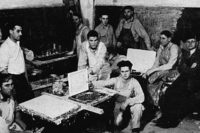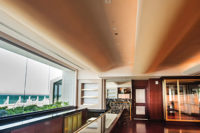Plenty of metal plaster base options are on the market, be it diamond mesh, woven wire or welded wire lath. But, which is best? Innovations in welded wire are making the decision more clear. Many contractors who work frequently with such substrates or laths say that self-furred welded wire laths that meet ASTM C933, Standard Specification for Welded Wire Lath, are the safe bet for long-term performance.
Self-furred welded wire laths are produced in various styles; designed for vertical and horizontal, heavy duty as well as light duty applications. These welded wire plaster bases offer a more installer-friendly method for applying stucco than alternative metal plaster bases, such as faster installation or lath, stucco job site efficiencies, green contribution and installed cost reductions. These wire laths’ self-furring characteristics create the necessary foundation for long lasting stucco walls by allowing full embedment of the plaster scratch coat. Plus, they are industry approved as an alternative product¹ wherever traditional diamond mesh lath and woven wire (i.e., “chicken wire”) are currently used.
Improved Stucco Performance
Those who work with lathing systems understand that one of its shortcomings is its own inherent design. If the wrong lath style is chosen for a particular application or it is poorly installed, the metal base doesn’t stay in the center of the completed stucco thickness. The lath moves around, often lying flat against the wall or pushing away from the surface in the scratch coat, even projecting out of the brown coat. This lack of uniformity jeopardizes the integrity of the stucco membrane, potentially causing it to crack or the metal plaster base to not encapsulate, thus increasing the likelihood of metal rust.
By contrast, self-furred welded wire laths are designed and manufactured to improve stucco embedment by providing consistent furring, which mitigates rust and cracking. The integrated furring designed into the vertical wires keeps the lath uniformly elevated on the wall (approximately 1/4-inch). This design provides an excellent substrate on which to apply the scratch coat for stucco or thin veneer stone.
The strength of welded wire lath is another key contributor for its enhanced performance. Structa Wire for instance, utilizes a wire that has a tensile strength of up to 240 pounds. Their wire designs are cold-formed to a flattened profile, which increases the wire tensile strength and break load. Compare this type to mild steel wire used in traditional wire lath products with break loads that top out at 150 pounds. Choosing open space, self-furred laths with superior strength will surely improve the overall structure and stability of a stucco or stone wall, which is in the best interest of the building owner for long term durability.
Newfound Job Site Efficiencies
Welded wire self-furred laths enhance stucco performance, which is reason enough to consider them for exterior walls. But, they are also easy for installers to manipulate and install. The same cold-rolled process of flattening some wires in the mesh to increase strength, those flat wires reduce curvature memory of the wire as it unrolls. These flat wire laths roll out flat without spring back during installation, thereby minimizing the potential for worker injury. Because these laths are easy to handle, installer’s on-the-job fatigue is reduced and worker productivity is increased.
Another inherent advantage of welded wire metal plaster bases is their self-furring qualities creates a uniformly furred lath surface for the scratch-coat. Furthermore, welded wire lath can be cut to the appropriate length, as many styles are manufactured wider than diamond lath sheets, thereby reducing the overlaps to be fastened on the wall. Welded wire lath rolls are lighter than sheet lath bundles or bulky woven wire rolls, and many allow lath fastening anywhere on the wire, rather than strictly at the furring point. Another benefit of producing in rolls versus sheets is that the length can be cut in the field to reach the next framing member. These continuous runs reduce waste and reduces end laps between framing members with need to wire tie another splice.
Green Contribution
Metal plaster bases are an integral part of a stucco or stone wall system and can count toward U.S. Green Building Council’s LEED certification requirements, an important factor in many of today’s construction jobs. In general, welded wire products use less metal than a traditional diamond lath sheet without loss of performance or strength. Most welded wire products are made from recycled steel with inherent recycled contents. Moreover, some manufacturers have developed packaging and transport strategies for these products that minimize their environmental impact.
Cost Considerations
For all their demonstrated benefits, self-furred welded wire lath is similar in cost to code compliant sheet laths (per square yard). Their real cost benefit is realized when the installer completes areas faster with less laps, has consistent furring and is simple to cut clean around openings in the wall. These characteristics make self-furred wire lath ideal for large walls, with repetitive openings where the rolls can be run over those doors, windows or other openings and then cut-back from those openings, increasing the speed of installation.
In the end, the strength of stucco is only as good as the strength of its substrate. Self-furred welded wire laths offer a more innovative method for applying stucco that ultimately creates a longer lasting wall cladding.
Proper Installation is Key
Proper metal lath installation is essential to the stability of plaster-based building exteriors. Below are some of the most common lath-related installation errors and how they can be avoided:
Improper Plywood Sheathing Installation—According to the American Plywood Association, plywood sheathing should be installed with a minimal gap of 1/8-inch between sheets to accommodate any expansion that may occur in the wood as a result of moisture intrusion. It is important to note that in cases where large amounts of moisture enter the exterior wall assembly, the plywood may delaminate or swell significantly, ultimately causing the stucco cladding to deteriorate. The best protection against these liabilities is an effective moisture management strategy within the exterior wall assembly, consisting of high-performance insulation, air barriers and vapor retarders or barriers.
Improper Installation of Water-resistive Barriers—Chapter 25 of the IBC states that exterior wall assemblies shall include two independent layers equivalent to Grade D paper that serve as water-resistive barriers. The only exception is the use of 60-minute Grade paper and a non-water-absorbing layer drainage plane, or rain screen.
Improper Fastening of Metal Lath—Improper fastening of metal lath is the most common installation error and is often a result of the lath being randomly stapled or nailed to the sheathing instead of the structural member. ASTM C1063 requires lath fastening at minimal intervals of not greater than 7 inches-on-center. Lath accessories’ flanges must directly touch the lath, with no weather barrier sandwiched in-between.
Improper Installation of, or an Inadequate Number of, Expansion & Control Joints—ASTM C1063 defines control joints as one-piece joints used to provide crack control for stucco shrinkage, drying and thermal expansion. The same standard describes expansion joints as two-piece joints used to accommodate some degree of movement in the stucco membrane caused by movement in the building or its components. Fastening the expansion joint flanges to sheathing, or leaving the lath un-cut behind the joint, negates the effectiveness of the control joint.
Just like all accessories, the control joint must be wire-tied to lath edges or, in some applications, attached to supports at spacing that ensures stability. On large, vertical surfaces, it is wise to make vertical joints continuous and cut horizontal joints to abut the verticals, with proper care taken to prevent the horizontal joints from impeding the vertical joints’ movement.
Improper Installation of Flashing or Sealants—Poorly installed or omitted flashing in areas where water can enter the exterior wall assembly can easily cause the cladding, sheathing and wood framing members to deteriorate. Mold growth may also result from extended moisture exposure, causing indoor air quality problems inside the building. Notifying the general contractor of any improperly installed flashing or areas where flashing was left uninstalled can save the project team some trouble in the long run.
References
1. ICC-ES Report 2017, Div. 09 Finishes, Section 092236 Lath









Report Abusive Comment